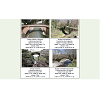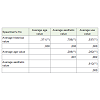Research Article
Exploring the Role of MonumentalValues in the Mountainous Regional Development Using TraditionalBridges as an Illustration
Maria Goula1, Nikolaos Hasanagas2*
1Maria Goula, Centre of Environmental Education of Makrinitsa, Magnisia, Greece
2Nikolaos Hasanagas, University Forest Administration, Aristotle University of Thessaloniki, Greece,
Corresponding author: Nikolaos Hasanagas, University Forest Administration, Aristotle University of Thessaloniki, Greece; E-mail: n.hasanagas@gmail.com
Citation: Goula M, Hasanagas N. Exploring the Role of Monumental Values in the Mountainous Regional Development Using Traditional Bridges as an Illustration. J Environ Soc Sci. 2016;3(1): 119.
Copyright © 2016 N Hasanagas. This is an open access article distributed under the Creative Commons Attribution License, which permits unrestricted use, distribution, and reproduction in any medium, provided the original work is properly cited.
Journal of Environmental and Social Sciences | Volume: 3, Issue: 1
Submission: 20/01/2016; Accepted: 10/02/2016; Published: 16/02/2016
Abstract
Aim of this research is to examine the contribution of traditional bridges as monuments to the regional development and to empirically analyze the possible interdependence of their monumental values. In 2015, 135 standardized questionnaires were answered by school teachers during an adult education project, including a visit to the bridges of Mpalta (Dipotama), Gorgianades, Karitsa and Xerolikos (Korischades) in the region Evritania, central Greece. Bivariate correlation test Spearman was used for the analysis. Riegl’s model (1903) of monumental values has been used (historical value, agevalue,aesthetic value, use value). All dimensions of all monumental values contribute to the creation of use value, as perceived by the interviewed visitors. The historical value enhances use value through technical features inspiring safety, reflections of past events etc. Tourists are supposed to be mostly attracted by architectural issues and local materials while the researchers are expected to focus on building methods or historical facts. Nostalgia enhances the perception of all possible uses, disclosing a desire of transition from “monumental” into “functional”, particularly to “multifunctional”. Remembrances ofromantic past, uniqueness, etc. are related with several dimensions of use value. Emotional stimulus seems to be induced to the tourists and researchers by the feeling of strength (eternity, immortality) characterizing “primitive” building materials and methods. Synergy appears among all four monumental values, but mostly among historical, aesthetic and use value. Thus, “knowing”, “feeling” and “using” seem to be induced by each other. The multiple monumental values characterizing the traditional bridges constitute them functional and of social, economic and entrepreneurial importance for the mountainous regions.
Keywords: Monument; Bridges; Forest policy; Environmental education; Rural development
Introduction
Aim of this research is to examine the contribution of traditional bridges as monuments to the regional development and to empirically analyze the possible interdependence of their monumental values. It is well-known that “monument” etymologically has a Latin origin. It means “reminding” or “advising”. People regard as “monument”a signified entity, normally permanent and relatively big, such as buildings or other constructions, statues, stones, landscapes, trees etc.Monuments can be either human-made (e.g. a building) or naturalstructures (e.g. a tree). Some monuments have been constructed fromthe beginning aiming at eternizing certain events or ideas. Some otherstructures became monuments by perceptions of people adopted afterthe formation of these structures. Riegl (original published in 1903)characterized the former as “intentional” monuments while the latter as “unintentional” [1]. Apart from that he also suggested four types ofmonumental “values”: the historical value (providing evidences aboutthe past), the age value (nostalgia, normally induced by the feeling ofdamaging, decay or abandoning), the art or aesthetic value (which,in wider sense, may be depicted as induction of aesthetic emotions,either coming in accordance or in conflict with current values) and theuse value (economic profit). It is discussable whether all these valuesappear in intentional and unintentional monuments. Eventually,it would be more accurate to speak of intentional or unintentionalvalues of an entity which may be perceived as a monument at aparticular moment and by particular viewers.
Old-fashioned bridges at mountainous areas are normally called-and possibly most by people of urban centers- “traditional”, asthey are arch-formed, relatively narrow and built by materials andtechniques which are quite unusual nowadays. In the past, thesebridges were of decisive social, political, economic and historicalimportance. Without them, even the structure of the “nation” andthe “state” could be different, as the society which is today regardedas a “single” nation and/ or state could be fragmented and dividedin several and smaller “societies”, “cultures”, and perhaps “nations”and “states”. These bridges had drastically contributed to the socialnetworking among mountainous communities, which otherwisewould remain isolated. It is, thus, a reasonable hypothesis that thesebridges are nowadays structures of monumental character, and thevisitors viewing them tend to perceive the four monumental valuesmentioned above.
The use value of these monuments is here regarded as theircontribution to the mountainous regional development. In thepresent analysis the use value is defined in a wide concept. Namely,it is not conceived by the authors as only the economic profit derivedfrom at least one of the other three values but as the profit derivedfrom the use of the bridge itself (passage). In other words, the usevalue here includes in a wider sense both the monument-related useand the instrumental use.
Literature review
Silva and Lea have intensively explored the links between ruraltourism and national identity, focusing on Medievalism, but withoutmeasuring value correlations [2]. Lignola and Manfredi haveprovided interesting interdisciplinary insights into technical aspectsof monuments’ restoration but they did not include perceptionalissues of the monumental values which are supposed to be restored[3]. Bakri et al. have deepened into issues of valuing built culturalheritage, examining both institutional and perceptional aspects butin urban and not mountainous rural context [4]. Pascual et al. [5],Pieraccini et al. [6] and Zvietcovich et al. [7] suggested a substantialmultidisciplinary approach to analyze, characterize and monitormonuments but they insist on photogrammetric and technologicalaspects rather than on the depiction or examination of their values asthey are perceived by the people. Fernandez et al. have also presenteda similar approach of surveying monumental settings, layingemphasis on topographical aspects, however, without suggestingparticular relations between monumental values and morphologicaland geophysical parameters of monumental elements and places [8].
Kaufmann focused on the conceptual and perceptual parametersof cultural heritage but following a humanities-based andpsychological or even psychiatric approach and not a quantitativemulti-dimensional empirical approach [9]. Artusson et al. proposed apolitical economy approach to monumental landscapes, focusing onritual and ceremonial context, however, from the Early Neolithic time[10]. Efe et al. presented the case of a monumental tree and discussedmonumentalization parameters, which can be useful for analyzinggeneral perception of monumental values [11].
Building materials have been insightfully explored by Ananiaet al. [12]. However, their approach considers only technicaland physical aspects (e.g. minero-petrographic and mechanicalparameters) and not value perceptions related to these materials.Tomao et al. have proposed an interesting model considering safetyparameters and classical monumental values in the light of the needof risk assessment and not in the context of values perception analysisand correlation [13]. Similarly, Salman et al. have meticulously dealtwith environmental impact and natural hazards on monuments,laying also emphasis on topographical and technical aspects, withoutconnecting the damage of a monument with the values it inspires tothe visitors [14].
Whitney et al. have intensively explored the complexity ofanthropogenic interventions, ecological patterns, deforestation andland use issues in monumental areas, but not strongly focusing on theperceptual parameters and their interdependence [15]. Matsumotohas tried an interesting analysis of monumental elements signifiedas political and religious symbols, through a prism of archaeological,iconographic, linguistic and cognitive approaches [16]. However, thisinsightful approach was hermeneutic rather than empirical.
Method
In 2015, 135 standardized questionnaires were answered byschool teachers during an adult education project implementedby Environmental Education Centers (units subordinated to theHellenic Ministry of Education), particularly by the centers ofMakrinitsa (Magnisia) and of Karpenisi. A basic description of thissample of 135 teachers is the following: Age: 6% under 30, 15% 30-40,and 79% over 40 years old. Gender: 48% female and 52% male. Schoollevel: 59% primary and 41% secondary school. During the project theparticipants visited four traditional bridges of the region Evritania(central Greece), specifically the bridges of Mpalta (Dipotama),Gorgianades, Karitsa and Xerolikos (Korischades). Evritania islocated in central Greece. The coordinates and the technical featuresof the bridges are presented in Figure 1. These bridges were appropriatefor the particular empirical research, because they are characterizedby obvious differences regarding monumental values and also arelocated in a quite mountainous area. Therefore, a multisided view ofthe monumental character of traditional bridges was provided.
The 135 teachers (interviewees) participated voluntarily in thisadult education project. Thus, the participants were specificallyinterested, at least to certain extent, in studying traditional bridges.Therefore, this is not a random sample representing the whole teachingstaff of Greece. However, this is not a weakness of the sampling, asthe aim of this research was not to provide descriptive statistics but only correlations. Additionally, the monumental values measured byquestionnaire, constitute non-physical, namely perceptual variables.Thus, the sample should be a judgment sample including individualsspecifically interested in traditional bridges so as to be able to perceive monumental values. Bivariate correlation test Spearman was used for analyzing the primary data at a significance level of 1% and 5%, so as to avoid the influence of possible outliers.
The four monumental values were operationalized on the basisof in-depth interviews with teachers and of the literature. Theinterpretation of the results was also based on in-depth interviewswith the participants.
Results and Discussion
The role of historical value
In the Table 1, it is observed that all dimensions of the historicalvalue present several positive correlations with the dimensions ofthe use value. More precisely, the impression of use of the bridge forpassage seems to be enhanced by the information perceived about thetraditional architecture and statics (.226), the building method (.206)and the historical facts (.186). This can be attributed to the fact thata bridge which is supposed to be built by constructors having paidattention to such technical parameters in the past gives the impressionthat it is still safe enough for passing through. Additionally, a bridgewhich is connected with historical events is natural to reflect an intensive passing of solders, refugees etc.
Not surprisingly, the interviewees consider a bridge to be atourist attraction, if it provides evidences about all dimensions ofhistorical value (.450 to .385) and at the utmost about traditionalarchitecture/ statics (.450) or about local materials (.421) used. Thisis understandable, considering that all these historical dimensions areattractive as they provide a multifaceted and irreplaceable combinationof knowledge, which may be either of local or of wider interest. Thearchitectural/ technical features as well as the local materials seem togive the most peculiar, specific and irreplaceable impression to thetourists, as they are often connected with local knowledge, culturalecology, “organic architecture” and eco-geography.
Concerning the economic activity, it is mostly supposed to befavored by evidences perceived about traditional architecture/statics(.211), technicians-builders (.198), possible sponsors (.354), who havesupported the construction or possibly the maintenance of the bridge,social needs (.175) (e.g. transport of patients, forest products andother commodities, teaching staff, cultural communication) that aresatisfied by the bridge, torrential phenomena (.196) (the existence orno existence of which may be of importance for the entrepreneurshipof the area), historical facts (.299) and neighboring constructions(.416).
The use of the bridge as an icon on postcards is a classical wayof a landscape exploitation. Thus, several dimensions of historical value (.334 to .240, .223 to .194, .184). especially the visible onessuch as architectural/ technical and material characteristics,geomorphological features or torrential phenomena during theiroccurrence are naturally conducive to its use as an icon on postcards.Historical elements which may be not visible but mentioned oradditionally re-produced on a postal card (such as historical facts)can also enhance the use of the bridge as an icon.
It is also understandable that historical elements which areinvisible and simultaneously mostly indifferent for the public donot influence the value of the bridge. These appear to be the possiblesponsors, what and how exactly was transported in the past andpossible neighboring constructions (.045, .141 and .174 insign.). Theirrelevance of the neighboring constructions for the picturesque useof the bridge, though they also may be related to the use of the streamwater (e.g. a fulling) or of the bridge itself (e.g. inn), implies that abridge appears to maintain an independent iconic signification andimportance. Hence, it may be perceived by the interviewed teachers not merely as an interesting icon but also as an autonomous symbol.The bridge can be perceived as a symbol of social networking undunification, over-coming obstacles (streams, canyons) “posed” bythe nature. Furthermore, it can be signified as a symbol of unifying“civilization”, considered to be developed in and coming from theaccessible plain, with the mountainous “wilderness”. As long as atraditional bridge is so seriously signified in the perception of theinterviewees, then it can easily stand autonomously on postcards andnot as a part of a landscape “needing” other landscape elements (likeneighboring constructions) in order to become “interesting”.
In the view of the interviewees, the research activity, namelythe attraction of researchers (academics or journalists), seems to bestimulated by all dimensions of the historical value (.467 to .348),as they are perceived by the interviewees. Therefore, these twocategories of public (tourists and researchers) seem to be in generalmotivated by the same stimulus : a wide range of discovering andexploring. However, according to the perception of the interviewees, these two categories are specifically differentiated in certain details:while, as afore-mentioned, the tourists seem to be mostly interestedin architectural issues and local materials, the researchers apparentlyfocus most strongly on building method (.499) and/ or historical facts(.488). This is understandable, as the building method is much moretechnically specific and the historical facts much more demanding inhumanities-related knowledge. In any case, none of them is at firstplace suitable for a mental relaxing but rather for satisfying visitorswith restless mentality.
The role of age value
In the Table 2, main dimensions of age value, namely nostalgia,feeling of damage proceeding on the bridge as a monument, andfeeling of needing maintenance, appear to be correlated with variousdimensions of use value.
Nostalgia seems to enhance the perception of all possible uses ofthe bridge (.228 to .386). Interviewees who feel nostalgia, induced bycomparing the actual situation of a bridge with the past, tend to desirea re-vitalization of the bridge and its conversion from “monumental”into “functional” (using it as a passage). They also tend to desire a multifaceted use of it (as tourist attraction, pole of economic activity,icon on postcards and subject of research). Such a full use of a bridgenot only enhances its reputation but also makes it widely known andeternizes it.
Interviewees feeling that a bridge is damaged through the time(.219) tend to deem it a subject of research. This can be interpreted asa reaction against to the proceeding damage. Researchers are expectedto save information about the past or information of technicalphysicalcharacter, before the bridge is fully destructed by natural orhuman factors. Interviewees who feel the need of maintenance arethose who tend also to believe that the bridge can still become a poleof tourist attraction (.292) and of economic activity (.183) (taverns,souvenir stores etc). This is reasonable as a bridge should be saved as amonument in order to function as a pole of development. Moreover,they also tend to see it as a subject of research (.451). This attitude canbe attributed to the fact that maintenance is necessary for saving thebridge as an object that may provide clear data and evidences to theresearchers.
The role of aesthetic value
The aesthetic value is a directly discernible value of a monument.Not only the beautifulness but also various other features, inducingfeelings/ emotions, may compose the notion of aesthetic value. Theaesthetic value differs from the age value, as the latter is supposed tobe more individualized while the former one is supposed to expressmore widely recognized features (e.g. uniqueness, safety, myths).
In the Table 3, interviewees who consider a bridge to beappropriate for passing seem to require the feeling of safety (.274)and/or its connection with folk songs (.176). The meaning of safety israther self-evident, as it could be regarded as a practical prerequisitefor walking on the bridge. The folk songs, though not of “practicalmeaning”, surely cite to romantic past and also ceremonial patterns,which may revive at present. Folk songs can be combined with localpeople who may celebrate, passing through the bridge.
In the view of the interviewees, a bridge may become a touristattraction on the basis of elements attributing it a character ofuniqueness or beauty, a feeling of strength (.560 to .263) or (.560 to.263) or a connection with myths and legends, folk songs and historicalmemories/ emotions (.468 to .473). The feeling of safety seems not toinfluence the perception of the bridge’s attractiveness (0.076 insign.).Similar results occur in the case of the economic activity (.304 and.233 as well as .225 to .268) and of the iconic use on postcards (.435and .451 as well as .270 to .371). Safety and strength feeling appearto be irrelevant to these two cases (.150 and .055 as well as .123 and-.014 insign.). In case of the research, the results are also similar (.528to .270 as well as .683 and .679) while safety feeling seems again to beirrelevant (-.030 insign.). Especially, strength perception is partiallyinduced by the view of vegetation roots which endanger the stabilityof the bridge. This constitutes an additional challenge for scientificresearch.
The irrelevance of safety feeling for these four dimensions of theuse value can be understood as a result of its purely practical characterwhich does not contribute to further emotional reactions. Accordingto the perception of the interviewees, strength feeling is the onlyelement relative to safety which appears to enhance tourist attractionand research. This can be attributed to the emotional stimulus inducedby the feeling of strength, namely the subsequent feeling of eternityand immortality, which are achieved with the “primitive” buildingmaterials and methods used on the bridge. For this reason, such astrength feeling becomes attractive for tourists. For similar reasons,strength appears also to be worth researching.
In general, uniqueness, beauty, tradition (myth/legends and folksongs) as well as history seem to stimulate tourists and researchers,as they provide a good escape from the monotony of the everydaylife (especially the urban life) and a multifaceted subject of research,combining natural, technical and socio-cultural issues.
Synergy of monumental values
In the Table 4, all four monumental values appear to depend oneach other. However, certain of them seem to maintain a strongerrelation to each other, as in the case of historical and aesthetic value(.706). Obviously, a bridge which provides evidences about the pastalso stimulates thereby aesthetic emotions. The “knowing” seemsthus to induce “feeling”. This can be attributed to the fact that theknowledge about the past revitalizes picturesque elements and scenesenhancing the potential of escaping aesthetic stereotypes which areimposed in the everyday life. In other words, the real aesthetic valueof a monument seems to lie in the breaking of the everyday life values.Besides that, the past induces emotional remembrances which buildvalues (such as heroism, stability) that may be perceived as beautifulfeelings and impressive world views.
The next strongest synergy occurs between the aesthetic and theuse value (.612), as perceived by the interviewed visitors. The aestheticvalue constitutes an attractive opportunity of recreation and escapingthe everyday monotony of stress. It is thus of high relevance for theuse value of a monument.
The third strongest synergy appears between historical and usevalue (.537). This is possible to occur either by inducing aestheticvalue and thereby use value, as analyzed above or directly (e.g.attracting researchers).
Conclusions, Suggestions and Points for FutureResearch
All dimensions of all values contribute to the creation of use value,as perceived by the interviewed visitors. Various interpretationsmay be proposed for understanding these correlations. Concerningthe historical value it enhances use value through technical featuresinspiring safety, reflections of past events, multifaceted knowledgeof local or wider interest, particularly related to cultural ecology,“organic architecture” and eco-geography, entrepreneurial use(forest and agricultural commodities etc.), satisfaction of social needs,iconic and symbolic content. Invisible elements such as sponsors orother details remain indifferent to the public. Tourists seem to bemostly attracted by architectural issues and local materials while theresearchers tend to focus on building methods or historical facts.
Concerning the age value, nostalgia enhances the perception ofall possible uses, disclosing a desire of transition from “monumental”to “functional”, particularly to “multifunctional”. Such an intensivere-vitalization of the bridge is also in accordance with the desire formaking it famous and “eternal”. Regarding the bridge as a subject ofresearch may also be understood as a reaction against proceedingdamage and for eternity. Maintenance is perceived as a prerequisitefor carrying out research.
As for the aesthetic value, remembrances of romantic past,uniqueness, beauty and feeling of strength are related with several dimensions of use value providing a) opportunity of escapingeveryday monotony and b) a multifaceted subject of research.Safety feeling appears to be only of practical and not of emotionalimportance. Emotional stimulus seems to be induced to the touristsand researchers by the feeling of strength (eternity, immortality)characterizing “primitive” building materials and methods.
Synergy appears among all four monumental values, butmostly among historical, aesthetic and use value. Thus, “knowing”,“feeling” and “using” seem to be induced by each other. The multiplemonumental values characterizing the traditional bridges constitutethem functional and of social, economic and entrepreneurialimportance for the mountainous regions. Even today, traditionalbridges can be used for the transport of people and commoditiesas well as for reaching areas which would be inaccessible throughthe normal forest road network. Enabling such accessibility is ofmultisided relevance for forest policy implementation (e.g. forest fireprevention or even fighting, improvement of habitats and silviculturalor other forestry actions, students and forest employees education),environmental education of pupils, architectural training, culturaland tourist promotion of a mountainous area through postcards,paintings, documentary films or other products of iconographic,historical and ethnographic interest or continuing folklore activities,and rural development by attracting tourists or transportingagricultural and forest products.
The maintenance, promotion and organized usage of traditionalbridges by the state and/or the regional authorities (prefecturesand municipalities) can be regarded as a rational option for thedevelopment of mountainous regions. The use of traditional bridgescan be enhanced by and integrated in various programs concerningcultural activities, tourism, building and monument restoration, ruralor even agricultural development.
A point of future improvement is to test the same indicatorsof monumental values of bridges on a larger sample of visitors.Formulating a typology of monumental features leading to certainprofiles (types) of monumental bridges is also a challenge for futureresearch. A comparison between perceptional data of monumentalbridges and of other kinds of monumental entities such as buildings,landscapes etc constitutes also an interesting question for futureresearch.
References
- Riegl A (1982) The Modern Cult of Monuments: Its Character and Its Origin [1903]. Oppositions 25, 21-51.
- Silva L, Lea J (2015) Rural tourism and national identity building in contemporary Europe: Evidence from Portugal. Journal of Rural Studies 38: 109-119.
- Lignola GP, Manfredi G (2010) A combination of NDT methods for the restoration of monumental façades: The case study of Monte di Pietà (Naples, Italy). Journal of Cultural Heritage 11: 360-364.
- Bakri AF, Ibrahim N, Ahmad SS, Zaman NQ (2015) Valuing Built Cultural Heritage in a Malaysian Urban Context. Procedia - Social and Behavioral Sciences 170: 381-389.
- Pascual MLVÃ, Carbó MTD, Carbó AD (2011) Characterization of Maya Blue pigment in pre-classic and classic monumental architecture of the ancient pre-Columbian city of Calakmul (Campeche, Mexico). Journal of Cultural Heritage 12: 140-148.
- Pieraccini M, Dei D, Betti M, Bartoli G, Tucci G, et al. (2014) Dynamic identification of historic masonry towers through an expeditious and no-contact approach: Application to the “Torre del Mangia” in Siena (Italy). Journal of Cultural Heritage 15: 275-282.
- Zvietcovich F, Castaneda B, Perucchio R (2015) 3D solid model updating of complex ancient monumental structures based on local geometrical meshes. Digital Applications in Archaeology and Cultural Heritage 2: 12-27.
- Fernández G, Teixidó T, Peña JA, Burillo F, Claros J (2015) Using shallow geophysical methods to characterise the monumental building at the Segeda I site (Spain). Journal of Archaeological Science: Reports 2: 427-436.
- Kaufmann D (2008) ‘Pushing the limits of understanding’: the discourse on primitivism in German Kulturwissenschaften, 1880-1930. Stud Hist Philos Sci 39: 434-443.
- Artursson M, Earle T, Brown J (2016) The construction of monumental landscapes in low-density societies: New evidence from the Early Neolithic of Southern Scandinavia (4000–3300 BC) in comparative perspective (November 5, 2015). Journal of Anthropological Archaeology, Volume 41, March 2016, Pages 1-18.
- Efe R, Soykan A, Cürebal İ, Sönmez S (2014) Kuyucak Monumental Cretan Maple (Acer Sempervirens L.) (Burhaniye - Balıkesir, Turkey). Procedia - Social and Behavioral Sciences, 120, 547-556.
- Anania L, Badalà A, Barone G, Belfiore CM, Calabrò C, et al. (2012) The stones in monumental masonry buildings of the “Val di Noto” area: New data on the relationships between petrographic characters and physical–mechanical properties. Construction and Building Materials 33: 122-132.
- Tomao A, Secondi L, Corona P, Giuliarelli D, Quatrini V, et al. (2015) Can composite indices explain multidimensionality of tree risk assessment? A case study in an historical monumental complex. Urban Forestry & Urban Greening, 14: 456-465.
- Salman AB, Howari FM, El-Sankary MM, Wali AM, Saleh MM (2010) Environmental impact and natural hazards on Kharga Oasis monumental sites, Western Desert of Egypt. Journal of African Earth Sciences 58: 341-353.
- Whitney BS, Dickau R, Mayle FE, Soto JD, Iriarte J (2013) Pre-Columbian landscape impact and agriculture in the Monumental Mound region of the Llanos de Moxos, lowland Bolivia. Quaternary Research, Volume 80, Issue 2, September 2013, Pages 207-217.
- Matsumoto M (2013) Reflection as transformation: mirror-image structure on Maya monumental texts as a visual metaphor for ritual participation. Estudios de Cultura Maya 41: 93-128.





